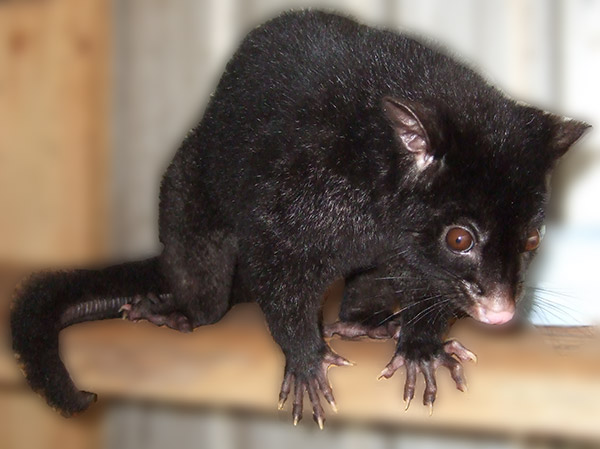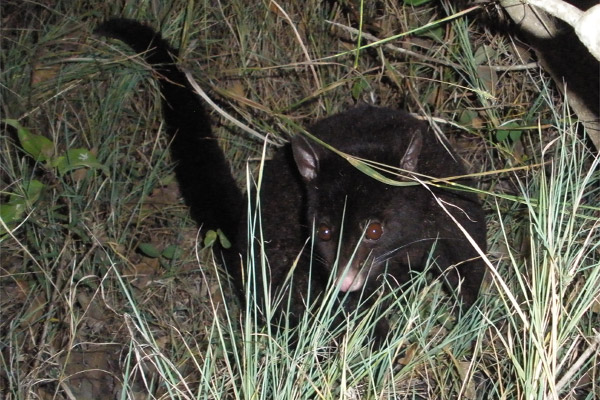 Trichosurus caninus
Trichosurus caninus
Other Common names: Short-eared Brushtail Possum, ‘Bobuck’
Physical description:
- Generally much darker and slightly more robust than the Common Brush-tail.
- Average body length 500mm, weight approx 4-4.5kg.
- Tail often used to grasp branches but cannot support its own body-weight.
- Males generally larger & heavier than females & may have reddish fur across shoulders.
- Males use scent glands under the chin, on the chest & near the anus to mark territory yet lack the characteristic staining of the chest like the Common Brush-tail as the fluid excreted is clear.
Ecology
- Arboreal (tree-living) occupying tall, open and closed forest and extending along margins of riparian forests.
- Nocturnal, spending daylight hours asleep in tree hollows, dead branches, thick ferns, epiphytes or even fallen logs.
- Natural diet consists of leaves, flowers & fruit of native plants. Capable of digesting leaves & fruits often toxic to other species. Also eats insects, bird eggs and scavenge meat if available.
- Communication is via scent markings, deep coughing & hissing noises when encountering other individuals.
- Threats include; land clearing & loss of habitat, and in urban areas road-deaths & dog attacks.
Breeding
- Mountain Brush-tails breed in March-May with occasional births outside this timeframe.
- Females may breed from 2 years of age but are generally more successful after the third and subsequent years.
- After a gestation of 15-17 days, young spend next 5-6 months in the pouch
- A further 2-5 months is spent riding on the mothers back & suckling from her.
- After weaning may persist in the area they are raised for a further 18-36 months.
Suburban Mountain Brushtail Possums:
- Mountain Brushtail Possums have proven highly adaptable to urban environments using trees, wildlife corridors, natural gullies, roofs and wall cavities often moving via telegraph poles, cabling and fences for traveling and foraging within close proximity to favored moist forest habitat.
- Human dwellings provide abundant warm, dry shelters, lots of available food plants from manufactured gardens and opportunity to scavenge from litter and rubbish bins.
- Hand feeding by residents and leaving domestic pet-food outside can also assist possums.
Living with Mountain Brushtail Possums
 So what can you do to try deterring a resident possum from your home?
So what can you do to try deterring a resident possum from your home?
Mountain Brush-tail Possums are often responsible for sleepless nights for suburban home occupants during entry, exit and general movements associated with roof and wall cavities. Placement of a possum box in a tree around your property is advised as your first option. These are available from produce stores, specialist artificial home constructors or you can make your own (see this site).
The exclusion of possums from your home is quite simple requiring a small effort on your own behalf.
- Inspect your roof for signs of obvious signs of entry. Access is often gained by broken tiles, lifting corrugated iron sheets, deteriorating timber eaves, loose guttering and poor workmanship by builders.
- Obvious signs include hair and urine staining. Feacal matter may also accumulate directly below the entry point.
- Inspect the entire roof. Possums may utilise more than one location and will look for other localities if the usual access is sealed.
- Place loosely “scrunched up” balls of newspaper in the entry of probable sites and inspect over a two day period to see which localities are being utilised. The paper will be either pushed out or pulled into the roof space.
- Place the paper back into the space and wait for the resident possum to make his early evening exit. Inspect the locality every 10-15 minutes to determine when this has occurred and simply block the point of entry with a hard fixture like sheet iron. Tightly compressed chicken wire reinforced with expandable building foam available in a can is ideal for hard to reach spaces. In some cases the replacement of a single tile or re-fixing of an iron sheet will solve the problem.
- The possum box you placed in your tree as option A may become the new home for your excluded visitor and provides a “win win” solution for all.
- In the event a possum is accidentally trapped during the process either reopen the closed entry point or remove a tile or raise a sheet of iron on your roof to allow exit. If this fails contact a local licensed reputable possum handler for immediate assistance.
Advice & Management
If your best efforts of excluding your possum/s fail then further advice and assistance may be your last resort.
Ecologically-minded possum advice, specialist trapping requirements, and legislative compliant release methods should be employed by licensed professionals for effective possum management.
Contact – your local licenced Possum specialist. For Brisbane and surrounds call Peter the Possum Man on (07) 3250 1111.
Trapping and further management of Mountain Brush-tail possums should be done in accordance with requirements stipulated by the Environmental Protection Agency and permits are issued to operators after examination as to the knowledge and suitability of the permit holder to actively manage suburban possums. Often these permit holders are able to provide proofing measures to exclude further entry.
Possums should not be relocated more than 25 meters from the point of capture after proofing has been conducted. Be sure to ask contractors what methods they employ and choose the one which provides a solution for yourself and the best welfare outcome for the possum/s being trapped.
